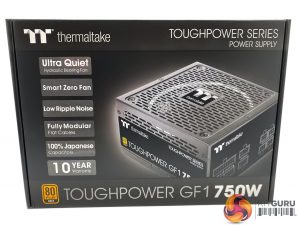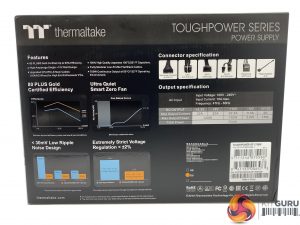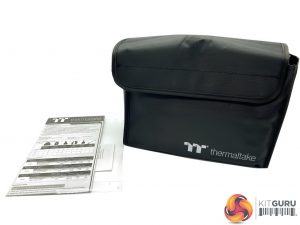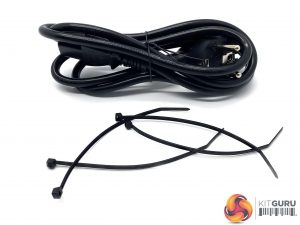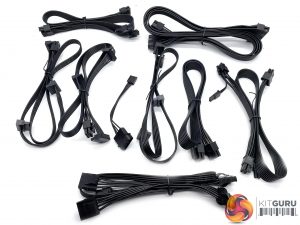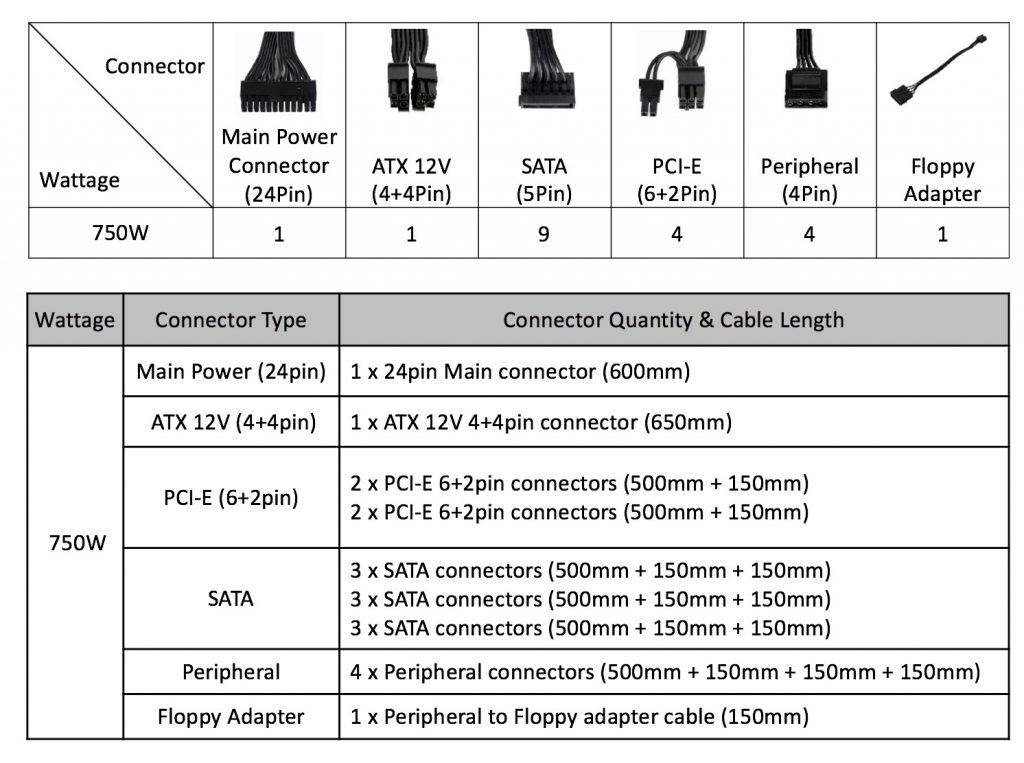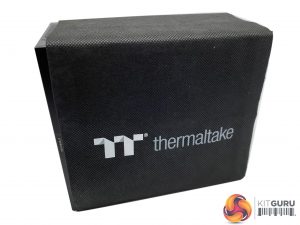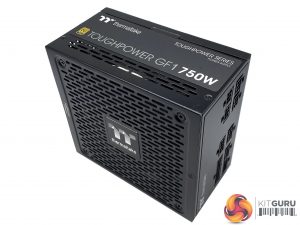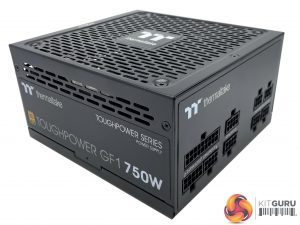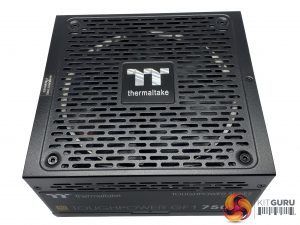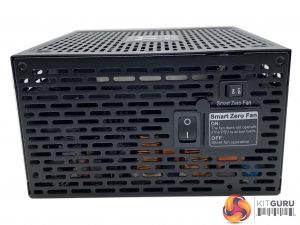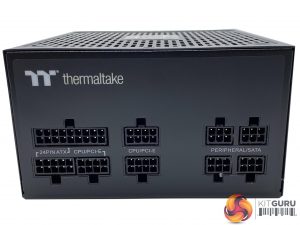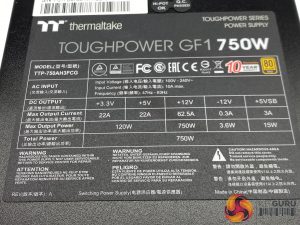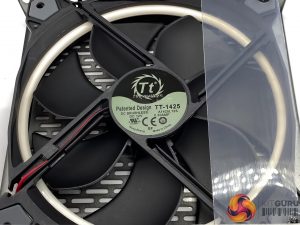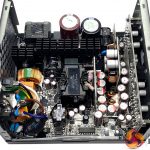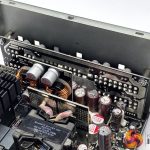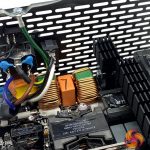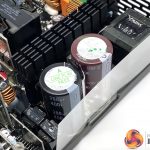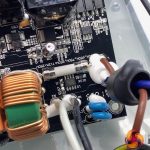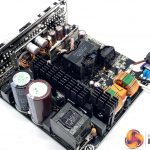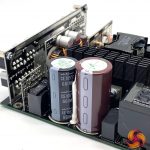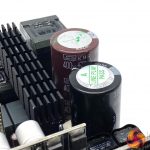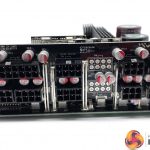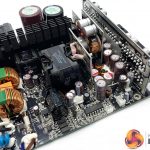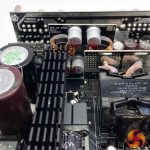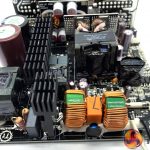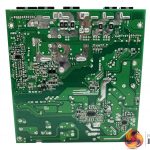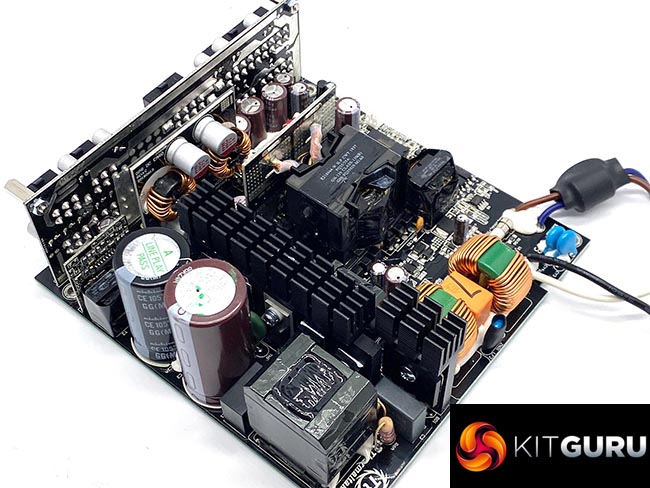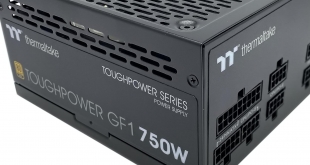
Thermaltake recently released a new range of 80 Plus Gold certified power supplies – called the ToughPower GF1. Many publications have been focused on the ARGB models, but we wanted to look at the plain GF1 750W model as its priced much more competitively. £99.98 is much easier to swallow than £134.99 for the ARGB version. Yes, thats £35 less if you can live without an RGB fan.
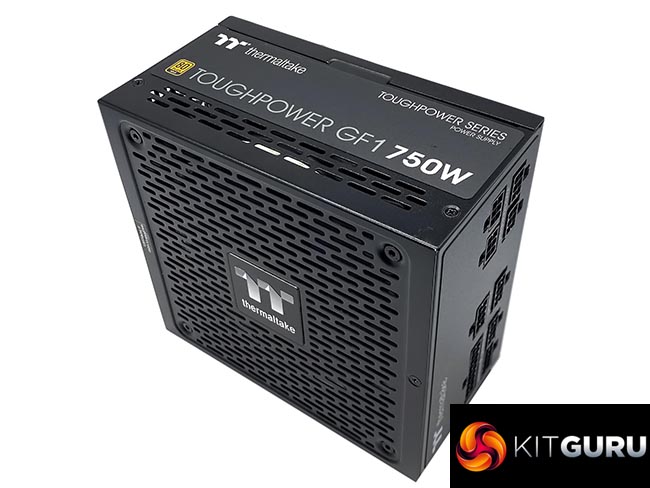
The Toughpower GF1 is 80 Plus Gold Certified, and it is fully modular. It ships with a hydraulic bearing fan, and the company state that they are using Japanese Capacitors throughout. We couldn't get information direct from Thermaltake on the OEM partner, but we will find that out when we open it shortly. No ARGB support with this model.
Features:
- 750W continuous output at 50°C/122°F operating environment.
- High efficiency Zero Cable Platform with premium build quality.
- 100% high quality Japanese 105°C/221°F capacitors.
- <30mV low ripple noise design.
- Extremely strict voltage regulation < ±2%.
- Fully modular low-profile flat black cables.
- Upgraded CPU/PCI-E main cables (16AWG wires) for high end enthusiasts' PCs.
- Ultra Quiet 140mm Hydraulic Bearing Fan delivers excellent airflow.
- Smart Zero Fan: Minimizes undesired noise.
- High amperage single +12V rail design.
- Intel C6/C7 states & ErP ready.
- Built-in industry grade protections: OCP, OVP, UVP, OPP, SCP, OTP.
- Dimension: 150mm(W)x86mm(H)x160mm(D).
- Safety approvals: CE/cTUVus/TÜV SÜD/FCC/BSMI/EAC certifications.
The Thermaltake Toughpower GF1 ships in a futuristic looking box with a high resolution image on the right and some key specifications listed on the left. We can see that Thermaltake are offering a 10 year warranty with the power supply.
The rear of the box showcases some of the key features – they are highlighting ‘low ripple noise' as well, which is quite an unusual thing to see on the outside of a retail box.
Inside the outer box is a bag of cables, and some literature on the power supply. Thermaltake also bundle a power cable and some cable ties for the final build.
This power supply is fully modular, and all the cables are ribbon style for ease of routing during the system build.
There are four PCI e cables included in the box, to suit systems with dual graphics card configurations. This particular power supply ships with a single ATX 12V 4+4 pin connector.
The power supply is wrapped inside foam, and protected inside a soft felt covering.
The Thermaltake power supply is actually quite nicely finished. The paintwork is reasonably thick and withstands fingerprints and surface scratches well.
That said, I am not a fan of the thick stickers on the sides – quality silk screening would look much nicer. I had to remove some of these stickers to get the unit open and it made quite the mess. This is obviously not something the end user will (or should) be doing, however when I see a power supply coated in thick non replaceable stickers, it doesn't give me a great feeling. Stickers can start to peel away from the surface underneath.
The side panels have little cuts in the metal work, to allow air to flow. The power supply measures 150 mm x 86 mm x 160 mm (WxHxD).
We can see the fan hidden behind a large metal grille on the top of the chassis. We will get a closer look at this fan when we open the chassis shortly to look inside.
One side of the power supply is vented to allow for air flow. Alongside a power button, power slot and ‘smart zero fan' button. The modular bay is clearly labelled and split across 2 rows.
| Thermaltake ToughPower GF1 750W PSU | |||||
|
DC Output
|
+3.3V
|
+5V
|
+12V |
-12V
|
+5Vsb
|
|
Max Output
|
22A
|
22A
|
62.5A |
0.3A
|
3.0A
|
| Total Power | 120W | 750W | 3.6W | 15W | |
| 750W | |||||
The Thermaltake ToughPower GF1 750W delivers 62.5A on the +12V rail, for 750W of the power output.
Thermaltake are using an ‘ultra quiet Hydraulic Bearing fan'. Its 140mm with the model number ‘TT-1425' on the sticker. You can actually buy these fans for £4.99 (HERE). Maximum Air flow is rated 1000 rpm – rated 12V 0.30A.
It can push a maximum of 60CFM of air with noise at 20dBa. There is a small section of clear plastic to direct air flow over specific parts of the power supply underneath. Fan life is rated at 120,000 hours MTBF.
Below a gallery of the insides of the power supply (if you cannot see this gallery you need to whitelist us in your ad blocker as they can interfere with our display code).
Thermaltake are using CWT as their OEM partner for this particular power supply. Its a pretty tidy looking design and I am happy to see that they are using Japanese capacitors in both primary and secondary stages.
The primary hold up caps are both high grade 105C Japanese models from Nippon Chemi Com (KMR series) and Nichicon – rated 400v 470uf and 400V 390uF respectively. Companies will often mix and match capacitors from specific families depending on what is available. This does not pose any concerns – it is good to see Thermaltake ensuring that high grade capacitors are being used throughout.
Soldering quality on the main PCB is pretty good overall although I was expecting to see a couple more heatsinks in place across the PCB, especially considering the somewhat efficiency
The power supply offers OCP, OVP, UVP, OPP, SCP and OTP.
Correctly testing power supplies is a complex procedure and KitGuru have configured a test bench which can deliver up to a 2,000 watt DC load.
Due to public requests we have changed our temperature settings recently – previously we rated with ambient temperatures at 25C, we have increased ambient temperatures by 10c (to 35c) in our environment to greater reflect warmer internal chassis conditions.
We use combinations of the following hardware:
• SunMoon SM-268
• CSI3710A Programmable DC load (+3.3V and +5V outputs)
• CSI3711A Programmable DC load (+12V1, +12V2, +12V3, and +12V4)
• Extech Power Analyzer
• Extech MultiMaster MM570 digital multimeter
• Extech digital sound level meter
• Digital oscilloscope (20M S/s with 12 Bit ADC)
• Variable Autotransformer, 1.4 KVA
|
DC Output Load Regulation
|
||||||||||
|
Combined DC Load |
+3.3V
|
+5V
|
+12V
|
+5VSB
|
-12V | |||||
|
A
|
V
|
A
|
V
|
A
|
V
|
A
|
V
|
A | V | |
|
75W
|
0.95
|
3.35
|
0.93
|
5.01
|
5.13
|
12.02
|
0.50
|
5.02
|
0.20
|
-12.03
|
|
150W
|
1.65 |
3.35
|
1.66
|
5.00
|
10.61
|
12.00
|
1.00
|
5.02
|
0.20
|
-12.02
|
|
375W
|
3.00
|
3.35
|
3.02
|
5.02
|
28.11
|
11.97
|
1.50
|
5.01
|
0.30
|
-12.01
|
| 565W |
4.05
|
3.34
|
4.07
|
5.01
|
42.94
|
11.93
|
2.00
|
5.00 |
0.30
|
-12.02
|
|
750W
|
4.90
|
3.33
|
5.24
|
4.99
|
57.48
|
11.89
|
2.50
|
4.98
|
0.50
|
-12.03
|
Load regulation proves to be solid throughout the range. There is a bit of a droop when the +12V rail gets hit with a lot of amps.
| Thermaltake ToughPower GF1 750W | Maximum Load |
| 833W |
We managed to reach around 833W before the unit would shut down gracefully, after the protection kicked in. This is around 83 watts more than the rated output.
Next we want to try Cross Loading. This basically means loads which are not balanced. If a PC for instance needs 500W on the +12V outputs but something like 30W via the combined 3.3V and +5V outputs then the voltage regulation can fluctuate badly.
| Cross Load Testing | +3.3V | +5V | +12V | -12V | +5VSB | |||||
| A | V | A | V | A | V | A | V | A | V | |
| 734W | 1.0 | 3.34 | 1.0 | 5.01 | 60.0 | 11.86 | 0.2 | -12.01 | 0.50 | 5.00 |
| 154W | 15.0 | 3.31 | 15.0 | 4.97 | 2.0 | 12.01 | 0.2 | -12.01 | 0.50 | 4.99 |
The unit passes our Cross Load testing. When hit with 60 AMPS the +12V rail held at 11.86, indicating some droop.
We then used an oscilloscope to measure AC ripple and noise present on the DC outputs. We set the oscilloscope time base to check for AC ripple at both high and low ends of the spectrum.
ATX12V V2.2 specification for DC output ripple and noise is defined in the ATX 12V power supply design guide.
|
ATX12V Ver 2.2 Noise/Ripple Tolerance
|
|
|
Output
|
Ripple (mV p-p)
|
|
+3.3V
|
50
|
|
+5V
|
50
|
|
+12V1
|
120
|
|
+12V2
|
120
|
|
-12V
|
120
|
|
+5VSB
|
50
|
Obviously when measuring AC noise and ripple on the DC outputs the cleaner (less recorded) means we have a better end result. We measured this AC signal amplitude to see how closely the unit complied with the ATX standard.
| AC Ripple (mV p-p) | ||||
| DC Load | +3.3V | +5V | +12V | 5VSB |
| 75W | 5 | 5 | 15 | 5 |
| 150W | 5 | 5 | 15 | 5 |
| 375W | 10 | 5 | 20 | 5 |
| 565W | 10 | 10 | 25 | 10 |
| 750W | 15 | 15 | 30 | 10 |
Noise suppression is held well within the industry rated parameters – hitting a maximum of 15mV at full load from the +3.3V and +5V rails. The +12V rail peaks at 30mV at full load
|
Efficiency (%) 240V
|
|
|
75W
|
89.4
|
|
150W
|
90.8
|
|
375W
|
91.9
|
|
565W
|
90.7
|
|
750W
|
89.2
|
Efficiency is quite good for an 80 Plus Gold power supply, peaking at close to 92% at 40-45% load. This efficiency drops to just over 89% at full load.
We take the issue of noise very seriously at KitGuru and this is why we have built a special home brew system as a reference point when we test noise levels of various components. Why do this? Well this means we can eliminate secondary noise pollution in the test room and concentrate on components we are testing. It also brings us slightly closer to industry standards, such as DIN 45635.
Today to test the power supply we have taken it into our acoustics room environment and have set our Digital Sound Level Noise Decibel Meter Style 2 one meter away from the unit. We have no other fans running so we can effectively measure just the noise from the unit itself.
As this can be a little confusing for people, here are various dBa ratings in with real world situations to help describe the various levels.
KitGuru noise guide
10dBA – Normal Breathing/Rustling Leaves
20-25dBA – Whisper
30dBA – High Quality Computer fan
40dBA – A Bubbling Brook, or a Refrigerator
50dBA – Normal Conversation
60dBA – Laughter
70dBA – Vacuum Cleaner or Hairdryer
80dBA – City Traffic or a Garbage Disposal
90dBA – Motorcycle or Lawnmower
100dBA – MP3 Player at maximum output
110dBA – Orchestra
120dBA – Front row rock concert/Jet Engine
130dBA – Threshold of Pain
140dBA – Military Jet takeoff/Gunshot (close range)
160dBA – Instant Perforation of eardrum
|
Noise (dBA)
|
|
|
75W
|
<28.0
|
|
150W
|
<28.0
|
|
375W
|
31.3
|
|
565W
|
33.9
|
| 750W | 36.3 |
The fan is this unit does not spin until the unit hits around 300 Watt load in our environment. At over 600 watts load it became audible to our ear, peaking at just over 36dBA at full load. At full load, the fan wasn't too intrusive but the pitch was fairly noticeable.
|
Temperature (c)
|
||
|
Intake
|
Exhaust
|
|
|
75W
|
36
|
40
|
|
150W
|
38
|
45
|
|
375W
|
39
|
48
|
|
565W
|
45
|
57
|
|
750W
|
47
|
61
|
The large fan works well to expel heat out the rear of the chassis. The overall results are not bad at all.
|
Maximum load
|
Efficiency
|
|
833W
|
88.6
|
At 833 watts, the efficiency level measures 88.6%. Not a practical situation to be running 24/7, but worth noting.
The Thermaltake ToughPower GF1 750W power supply has proved quite successful in our tests this week. Its not a groundbreaking power supply by any measurement, but it is capable of holding a steady maximum rated 750 watt load without any issues.
Technically the unit delivers quality power, holding a decent delivery, even under higher load situations. There is a little droop apparent on the +12V rail under certain load situations but it does not pose any problems in real world conditions.
The use of high grade Japanese capacitors throughout is reassuring. I was pleased to see a combination of 105c Nichicon and Nippon Chemi Con used as primary hold up capacitors, along with some quality caps on the secondary stage. Thermaltake have not cut corners in this regard, which is positive to note.
Aesthetically, it is not a bad looking power supply. I am not impressed with the abundance of thick side stickers. I would much rather have some nice silk screening on the panels, however I appreciate this is to keep the costs down a little. It is after all an 80 Plus Gold power supply, so hitting a sub £100 price point will certainly be a discussion point.
This actually leads me nicely into something I noticed early on in this review about this particular family of power supplies. If we take a look at the new range of Toughpower GF1 power supplies on SCAN over HERE we can see that Thermaltake are selling ARGB and NON ARGB versions.
When I was offered this power supply I specifically asked for the non ARGB version. I appreciate a lot of people enjoy RGB features, but I would certainly not be willing to pay £35 extra for this. The ARGB version of this power supply is £134.99 (HERE), and this review sample today without RGB is priced at £99.98 (HERE). I checked with Thermaltake, and the only difference is the RGB fan.
There are some alternatives on the market right now. If you are trying to cut as much cost as possible, then the £75 700W Kolink Enclave 80 Plus Gold unit deserves some consideration (KitGuru review HERE). You save £25, but its worth pointing out that you do not get Japanese capacitors, or even a power cable. If you factor in £5 for a power cable, then personally I would feel that investing £20 into high grade 105c Japanese capacitors is a wise move.
Pros:
- Fully modular.
- Japanese capacitors throughout.
- decent finish.
- very competitively priced.
- 10 year warranty.
- technically capable.
Cons:
- not a fan of the thick stickers on the side panels.
- fan can get a little irritating at higher loads.
Kitguru says: The Thermaltake Toughpower GF1 is a solid purchase at just under £100. We are not sure the ARGB fan version makes a lot of sense as it increases the price by £35 – pushing it firmly into Seasonic territory.
 KitGuru KitGuru.net – Tech News | Hardware News | Hardware Reviews | IOS | Mobile | Gaming | Graphics Cards
KitGuru KitGuru.net – Tech News | Hardware News | Hardware Reviews | IOS | Mobile | Gaming | Graphics Cards
